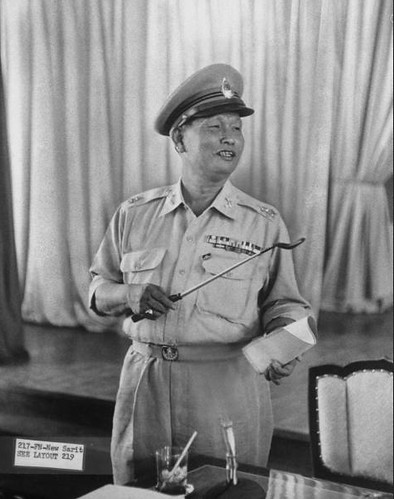Ajarn Piyabutr Saengkanokkul made the observation that:
"When we speak of French history, why is it that we only think about the French Revolution and the beheading and overthrow of the king? Really, there are many other interesting issues. Not every uprising in French history led to the overthrow of a king. It took a long time to set the system of political life in France. France had to deal with the king, and not until 1899 did it manage to bring him under control and move towards a progressive republic, after becoming a republic in 1870 and going through a gradual process and compromise with royalists.
The perception of Thais is that France is equivalent to overthrowing the monarchy. France means radical. People who study there are dangerous.
It's not true. Among those who graduated from France, many are old-fashioned and many are conservative. They are probably interested in Field Marshal Pétain and the power-serving legal techniques of the Vichy period.”
I've come up with some points which could be interesting for discussion:
2 interesting points arise from Ajarn Piyabutr’s comment above.
1.) It is a historical fact that during the reigns of Rama 5 and 6, palace nobles were sent to study in various European countries. They were sent to countries which had monarchies and/or in which the institution of the monarchy retained power and influence in politics and rule, more often than to those which were republics. Therefore, England and Germany were more frequently selected than France. Those who went, regardless of being lords or aristocrats, had a royal letter explicitly instructing them to select and bring back things that would be of benefit to the country and not to pick inappropriate political models, such as political parties or parliament. During his reign, Rama 6 even had Thai students, who would go to study abroad, make a pledge, whose content was in the vein of that after studying, they not consider rebelling against the nation or the crown. Something like that.
2.) The trend of conservatism-authoritarianism, from the French jurists and political scientists and based on the form of De Gaulle’s Fifth Republic, became very dominant in the period following WWII. This is the inspiration between Amorn Chantrasomboon and Khamnoon Sittisaman* when they talk about political reform and the return of the royal prerogative. The only alteration is to replace a strong leader, like De Gaulle, with a Thai-style leader, like Field Marshal Sarit Thanarat, and to place the monarchy in the primary reference position of state-building power instead. The reference to this model of politics or so-called “Gaullisme” has been made since 1958. Field Marshal Sarit held it up to threaten insubordinate and rebellious MPs.

Field Marshal Sarit Thanarat
The 3 Faces of Field Marshal Sarit
The conversation about France with Ajarn Piyabutr Saengkanokkul made me think about interesting aspects of Field Marshal Sarit.
After already being ruled by Field Marshal Phibun for many years, falling under the barbaric power and influence of Police General Phao Sriyanond (who possessed the nickname, “Iron Man of Asia), whose police henchmen, the “Knights of the Diamond Ring,” cruelly killed journalists and opposition figures -- whether they were in the vein of Ajarn Pridi or from Isan or Thai Muslim leaders from the southern border provinces or Kuomintang or independent people who refused to line up in rows -- caused many different opposition groups to cast Field Marshal Sarit Thanarat in a hopeful light. They were hopeful when they saw him play a role in resisting the government of Field Marshal Phibun. This was especially the case in early 1957, when students demonstrated against the dirty election and broke down the door of Government House. On that occasion, Sarit came out to speak to the mob, and to express his close loyalty to the monarchy.
The left, especially the journalist-intellectuals, imagined that Sarit might become the “Nasser” of Thailand. As a nationalist soldier, Nasser led his followers to overthrow the regime of the monarchy in Egypt. He then carried out a policy of non-alignment and resisted Western imperialism (for example, recognizing and opening diplomatic relations with Communist China and strengthening relations with the Soviet Union). Nasser seized the Suez Canal, titled to a foreign company in which Western governments held shares [Suez Canal Company -- trans.] and nationalized it. Then, England, France, and Israel sent forces to occupy the Suez Canal and bomb Cairo. Finally, America and the Soviet Union intervened to mediate at the United Nations to make these three countries cease and withdraw their forces.
As for the right, especially the jurists and political scientists, their dream was that Sarit would perhaps become the “De Gaulle” of Thailand. This would aid in solving the problem of the insecure government, which lacked stability due to insubordinate MPS who bargained over the budget and frequently engaged in bribery. They made it impossible for the state bureaucrats to govern as they wished. [Sarit could reform Thai politics as] De Gaulle had reformed French politics when he created the new Constitution of the Fifth Republic. The new Constitution was created in order to redress the problems of political instability by making the administrative branch stronger, and not as easily or frequently overthrown by MPs in Parliament, such as in the Fourth Republic.

“Nasser” (left) and “De Gaulle” (right)
The left viewed Sarit as “Nasser.” The right viewed Sarit as “De Gaulle.”
As for Sarit, in truth he saw himself as a “paternal dictator.” A person who tore up the Constitution. A person who toppled “Western-style” democracy. A person who purged and stubbed out the legacy of the 1932 revolution, in terms of both symbols and legal structure, in order to invent “Thai-style” democracy whose legitimacy is derived from the monarchy.
* Amorn is a retired academic. Khamnoon is an ASTV-Manager columnist and an appointed senator. Both are closely associated with the yellow-shirt People’s Alliance for Democracy.
Source: สนทนาแลกเปลี่ยนว่าด้วยตัวแบบการเมืองฝรั่งเศส และ 3 หน้าของจอมพลสฤษดิ์
Translated by Tyrell Haberkorn

